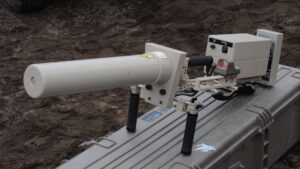The Royal Navy aircraft carrier "HMS Queen Elizabeth" left the port of Hamburg again on Saturday, 23 November 2024, without any significant incidents - except for one minor blemish.
As confirmed by the Territorial Command of the German Armed Forces in Berlin, a drone with a diameter of over 2 metres was spotted above the aircraft carrier moored at the Steinwerder cruise terminal on Friday. Such aircraft are launched from the DronePort of the Hamburg Port Authority (HPA) not far from the harbour museum, but this drone was not one of them.
In addition to the harbour facilities, which were guarded by the homeland security company, and the water-side security provided by the water police, the airspace around the "HMS Queen Elizabeth" was of course also closed. Among other things, a Bundeswehr drone defence unit with the HP-47 jamming system was deployed to secure the airspace, although no "shots were fired" (electromagnetically!), according to the Bundeswehr.
The jammer could have interrupted the connection between the control system and the aircraft, which would have led to the drone automatically returning to the starting point or crashing.
However, witnesses claim to have observed that the unidentified drone had disappeared on the site of a container terminal. Judging by its dimensions, it is more likely to be an aircraft used for military reconnaissance and official aerial image documentation than a private hobby device.
Deployment in the German Armed Forces
As the information portal bundeswehr.de reported in March 2023, the HP-47 jamming system has already been in use in the Bundeswehr since 2017/2018 with MINUSMA in Mali (Mission Multidimensionnelle Intégrée des Nations Unies pour la Stabilisation au Mali).
The Bundeswehr also uses this system in Lithuania. On average, three unknown drones fly over the Pabradė military training area every day. This is where the multinational elements of the eFP (enhanced Forward Presence Battlegroup) train, as well as the Adrian Rohn and Herkus camps, where the USarmed forces have now installed fixed sensors and effectors for drone defence. Incidentally, every flight movement in the Pabradė area is detected and the flight path of the drones is tracked.

Interfering transmitter system HP-47
The shoulder-mounted jammer has a length of 113 centimetres and a weight of 8.5 kilograms. The system consists of two portable jammer cannons and a stationary sensor unit. There are three types of jamming for the HP-47:
On the one hand, it suppresses the Global Navigation Satellite System (GNSS) signal, whereby the drone can no longer be controlled via GPS. Dhe Although the drone continues to transmit data and images and is still controllable, it cannot fly programmed routes with GNSS/GPS support outside the pilot's line of sight.
With the second sturgeon variant the Connection of the remote control (RC - Remote Control) i.e. the signal between the drone and the operator interrupted. Control as well as image and data transmission are then no longer possible. Depending on how the drone is programmed, automatic emergency programmes are activated after the remote control connection is disconnected. Either the drone back to the take-off point, or it initiates an automated emergency landing on site. With older models in particular, this interference can also lead to a crash. of the aircraft.
The The third possible application is the transmission of GNSS and RC jamming signals, whereby the drone immediately makes an emergency landing because it has become disorientated and can no longer find its way back to its starting point.
For tests in an open area was the jammer in Lithuania over several kilometres and even without visual contact.
Why not do it now?
This immediately raises the question of why the thing wasn't simply pulled out of the sky? What scruples should prevent a decision-maker from releasing the fire?
It's the tiresome drone dilemma in peacetime over populated areas: does the drone itself pose a danger - (should it be "armed" with an explosive device or similar) or does the falling drone or parts of it fundamentally pose a risk of injury to uninvolved persons?
The question arises in particular when electronic warfare is used and - as is the case every day in Ukraine - an explosive charge of the combat drone is not immediately destroyed by a hit, whereby the damage is nevertheless caused on the ground by the untargeted impact.
ajs, bundeswehr.de, ndr, tag24, thb











2 responses
Sebastian,
I have come to the same conclusion. But Hamburg politicians don't like to talk about COSCO and Tollerort.
Just off the R 08 was a large container freighter belonging to a Chinese state shipping company, which also happens to be a shareholder in one of the Hanburg terminals. A rogue who thinks evil of it...